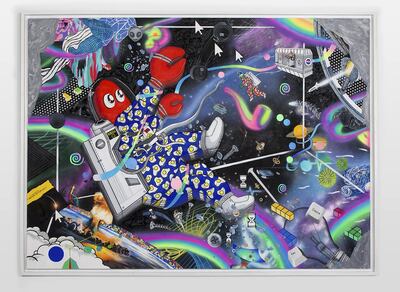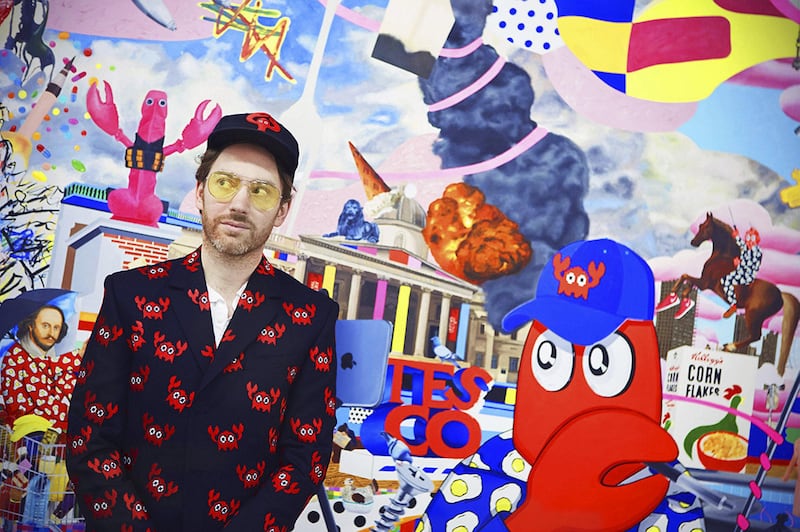The work of Philip Colbert is brash, bold and conveys an enormous sense of fun. The Scot, 36, who has worked across music, fashion and design, is currently exhibiting at the Saatchi Gallery in London, where he is showing eight large-scale pieces in oil.
Paul Foster of the Saatchi Gallery says of the artist: “Philip Colbert’s works are energetic and vibrant examples of contemporary art that illustrate the saturation of art history and pop culture in society.”
Colbert draws on pop art, surrealism and a keen knowledge of art history and mass consumerism to comment on modern concerns such as our addiction to social media, climate change and the threat of nuclear war. He pulls it all off with aplomb, aided by his tongue-in-cheek storytelling.
His work has an appeal across age groups – during a recent tour of the gallery, the room was permanently busy, with children and adults engaging with Colbert's work and the artist, asking for pictures of him in front of his work.

Your works in this show are narrated by a lobster character. Who is this?
In the age of the internet forming such an important role in communication and art, the lobster character is my art and internet meme/alter ego. I have always seen the lobster as a key protagonist of surrealism and the lobster character has evolved in my work. I have been drawing lobsters for years – they started appearing in my clothing designs and art works, and people started associating me with lobsters. I started wearing lobster-patterned suits a lot, and as time evolved, I became a sort of lobster man.
In the paintings, my lobster self wears my iconic fried-eggs suits and brings my art language and self into the paintings that threads a narrative between the works. Through painting, I like the idea that my art and design world, which I have made real then becomes fantasy again, further blurring the boundaries of reality and fantasy.
The paintings are littered with emojis and other modern imagery. Are you influenced by digital media?
The paintings reflect the digital-media influence on our perspective and the saturation of our current pop culture. In the 1960s, pop was an idolised dream; today, it is a saturated reality. As an artist, I consume so much through Instagram, it has changed the way I paint.
How has the show been received so far?
I have been really happy with the public's response to the paintings. That's the amazing thing about the Saatchi Gallery: it's more like a museum, open for all, rather than a commercial gallery.
Is pop art still relevant?
The paintings engage in the art historical dialogue of painting and pop, from early western art history to now, from Rubens to Soutine to Rosenquist. I love the dialogue of painting’s constant strife for meaning and power of expression. I also still believe in the philosophy of pop and the ultimate value of the everyday. The paintings also tap into political issues in Britain, such as Brexit, over-consumption and fears of nuclear wars.
You reference an enormous amount of artists in your work – I picked up Lucian Freud and Francis Bacon in one piece alone. What is the thinking behind this? Is it respectful?
With the art historical references that saturate my paintings, I am playing with what I see as an art language. These past artists' work has created a common symbolic vocabulary, just as poets refer to ideas themes from the history of poetry. I then play with this language and mix it with my own. It's about understanding the limits and boundaries of language, hence why I use common ideas with meaning. For me, the philosophy of pop is about using the most meaningful common language that unites us not divides and taps into the greatest value of meaning. I love the everyday – that has the most meaning for me. Life is the true value of art, and art can, at best, be a broken reflection of this.
Philip Colbert: New Paintings is at the Saatchi Gallery, London, until October 30
______________
Read more:
[ Not alone, but first: Saudi women curate British contemporary art ]
[ Sotheby's Howard Hodgkin auction exceeds expectations ]
[ Preview: Christie's London auction of Middle Eastern Modern and Contemporary Art ]
______________





